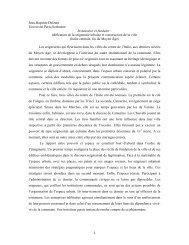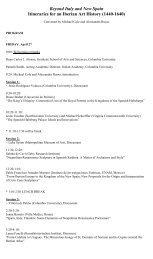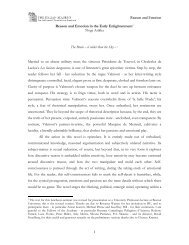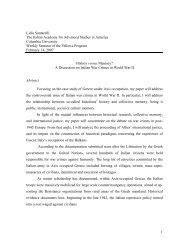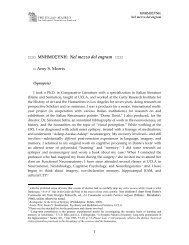Why are fertility and participation rates so low in Italy - The Italian ...
Why are fertility and participation rates so low in Italy - The Italian ...
Why are fertility and participation rates so low in Italy - The Italian ...
Create successful ePaper yourself
Turn your PDF publications into a flip-book with our unique Google optimized e-Paper software.
<strong>Why</strong> <strong>are</strong> <strong>fertility</strong> <strong>and</strong> <strong>participation</strong> <strong>rates</strong><br />
<strong>so</strong> <strong>low</strong> <strong>in</strong> <strong>Italy</strong> (<strong>and</strong> Southern Europe)?<br />
<strong>Why</strong> <strong>are</strong> <strong>fertility</strong> <strong>and</strong> <strong>participation</strong> <strong>rates</strong> <strong>so</strong> <strong>low</strong> <strong>in</strong> <strong>Italy</strong> (<strong>and</strong> Southern<br />
Europe)?<br />
Daniela Del Boca<br />
University of Tur<strong>in</strong> <strong>and</strong> CHILD<br />
Paper prep<strong>are</strong>d for presentation at the <strong>Italian</strong> Academy at Columbia University<br />
October 29, 2003<br />
Introduction<br />
Over the last decades labour market <strong>participation</strong> of women <strong>in</strong>creased, while <strong>fertility</strong><br />
decl<strong>in</strong>ed <strong>in</strong> most advanced countries. This pattern is consistent with microeconomic<br />
predictions: economic models of <strong>fertility</strong> behaviour predict <strong>in</strong> fact that an <strong>in</strong>crease <strong>in</strong><br />
women’s school<strong>in</strong>g levels <strong>and</strong> wage <strong>rates</strong> leads to an <strong>in</strong>crease <strong>in</strong> their labour supply <strong>and</strong> to a<br />
reduction <strong>in</strong> <strong>fertility</strong>. <strong>The</strong> existence of an <strong>in</strong>verse relationship between <strong>fertility</strong> <strong>and</strong><br />
<strong>participation</strong> was theoretically established by Becker <strong>and</strong> Lewis (1973) <strong>and</strong> Willis (1973)<br />
<strong>and</strong> empirically documented by Butz <strong>and</strong> Ward (1979) for the U.S. <strong>and</strong> M<strong>in</strong>cer (1985) on a<br />
cross-country basis.<br />
Table 1. Fertility Rates <strong>and</strong> Female Participation <strong>rates</strong> <strong>in</strong> selected countries<br />
Country Fertility <strong>rates</strong> Participation <strong>rates</strong><br />
1977 2000 1977 2000<br />
<strong>Italy</strong> 1.98 1.21 37.6 44.1<br />
France 1.86 1.71 53.0 59.8<br />
Spa<strong>in</strong> 2.65 1.25 33.0 47.1<br />
Greece 2.27 1.30 33.3 47.5<br />
Denmark 1.66 1.75 64.7 75.1<br />
Sweden 1.65 1.62 70.0 74.5<br />
U.K. 1.69 1.71 56.3 67.5<br />
Source: OECD Eurostat 2002 Statistics <strong>in</strong> Focus<br />
Policies aimed to support <strong>participation</strong> may have the undesired effect of a decl<strong>in</strong><strong>in</strong>g<br />
population. On one h<strong>and</strong> a smaller population reduce human pressures on the environment<br />
1
<strong>Why</strong> <strong>are</strong> <strong>fertility</strong> <strong>and</strong> <strong>participation</strong> <strong>rates</strong><br />
<strong>so</strong> <strong>low</strong> <strong>in</strong> <strong>Italy</strong> (<strong>and</strong> Southern Europe)?<br />
<strong>and</strong> limited natural re<strong>so</strong>urces. On the other h<strong>and</strong>, negative consequences of the <strong>fertility</strong><br />
decl<strong>in</strong>e <strong>in</strong>clude a <strong>low</strong>er growth <strong>in</strong> the population <strong>in</strong> work<strong>in</strong>g age, <strong>in</strong> the real GDP as well<br />
domestic sav<strong>in</strong>gs. A grow<strong>in</strong>g number of people who have few immediate family ties which<br />
will <strong>in</strong>crease the dem<strong>and</strong> for formal provision of services, young children <strong>and</strong> older people<br />
with no sibl<strong>in</strong>gs. An underst<strong>and</strong><strong>in</strong>g of this relationship is therefore relevant to policy makers<br />
<strong>in</strong> ways which go beyond theoretical speculation.<br />
Recent analyses focus<strong>in</strong>g on the temporal pattern of <strong>fertility</strong> <strong>and</strong> female <strong>participation</strong><br />
show that as early as the mid-1980s, the sign of the cross-country correlation changed from<br />
negative to positive <strong>and</strong> became more volatile. After 1985, the <strong>participation</strong> of women <strong>in</strong> the<br />
labour market cont<strong>in</strong>ued to <strong>in</strong>crease <strong>in</strong> all countries, but <strong>fertility</strong> <strong>rates</strong> started to decl<strong>in</strong>e at a<br />
<strong>low</strong>er rate or, <strong>in</strong> <strong>so</strong>me countries, began to grow aga<strong>in</strong>.<br />
<strong>The</strong> countries that currently have the <strong>low</strong>est levels of <strong>fertility</strong> (Spa<strong>in</strong>, <strong>Italy</strong> <strong>and</strong><br />
Greece) <strong>are</strong> those with relatively <strong>low</strong> levels of female labour force <strong>participation</strong> while the<br />
countries with higher <strong>fertility</strong> levels (Denmark, France) have relatively high female labour<br />
force <strong>participation</strong> <strong>rates</strong>.<br />
<strong>The</strong> <strong>in</strong>terpretation of the temporal change <strong>in</strong> the relationship between <strong>participation</strong><br />
<strong>and</strong> <strong>fertility</strong> has ma<strong>in</strong>ly been found <strong>in</strong> the changes <strong>in</strong> <strong>so</strong>cial norms towards work<strong>in</strong>g mothers<br />
<strong>and</strong> <strong>in</strong> the effects of policies that dim<strong>in</strong>ish <strong>in</strong>compatibilities between childrear<strong>in</strong>g <strong>and</strong><br />
female employment: more generous p<strong>are</strong>ntal leave, greater availability of childc<strong>are</strong>, <strong>and</strong><br />
greater opportunities for flexible hours <strong>and</strong> part-time employment (Ermisch 1989, Hotz <strong>and</strong><br />
Miller 1988, Del Boca 2002, Brewster <strong>and</strong> R<strong>in</strong>dfuss 2000, Benjam<strong>in</strong> 2001). <strong>The</strong> empirical<br />
evidence <strong>in</strong>dicat<strong>in</strong>g a positive relationship between women’s <strong>participation</strong> <strong>and</strong> <strong>fertility</strong> is<br />
certa<strong>in</strong>ly encourag<strong>in</strong>g <strong>in</strong> view of pension system susta<strong>in</strong>ability. Boost<strong>in</strong>g female<br />
employment, if supported by such policies, will not necessarily lead to significant decl<strong>in</strong>es<br />
<strong>in</strong> <strong>fertility</strong> as was experienced <strong>in</strong> the past.<br />
Other studies of this phenomenon have shown different results, reveal<strong>in</strong>g a weaker<br />
<strong>and</strong> less significant correlation, but not a change from a negative to a positive sign. <strong>The</strong>se<br />
analyses, pool<strong>in</strong>g cross country <strong>and</strong> time series data, al<strong>low</strong> for country-effects <strong>and</strong> show that<br />
only <strong>in</strong> Mediterranean countries is there a negative correlation between <strong>fertility</strong> <strong>and</strong> female<br />
employment (Engelhardt et al. 2001). This result implies that it is important <strong>in</strong> these<br />
countries for female <strong>participation</strong> <strong>and</strong> <strong>fertility</strong> to be considered as a jo<strong>in</strong>t decision <strong>and</strong> that<br />
2
<strong>Why</strong> <strong>are</strong> <strong>fertility</strong> <strong>and</strong> <strong>participation</strong> <strong>rates</strong><br />
<strong>so</strong> <strong>low</strong> <strong>in</strong> <strong>Italy</strong> (<strong>and</strong> Southern Europe)?<br />
policies encourag<strong>in</strong>g <strong>fertility</strong> may have an adverse effect on female employment <strong>and</strong> vice<br />
versa (Del Boca 2002).<br />
Fertility is <strong>low</strong> today where was very high decades ago <strong>and</strong> it is high today where<br />
was very <strong>low</strong>. Social policies have been implemented <strong>in</strong> most Northern <strong>and</strong> Central<br />
European countries to make childrear<strong>in</strong>g less difficult to be reconciled with employment. In<br />
<strong>so</strong>me countries the view <strong>in</strong> favour of pro-natalist actions has prevailed, <strong>and</strong> government<br />
<strong>in</strong>tervention has been directed towards promot<strong>in</strong>g higher <strong>fertility</strong>. In others, the view that,<br />
<strong>in</strong>dependently of the possible consequences on <strong>fertility</strong> levels, governments <strong>are</strong> not justified<br />
<strong>in</strong> <strong>in</strong>terfer<strong>in</strong>g with <strong>in</strong>tact families’ decision <strong>and</strong> <strong>in</strong> particular with how many children to<br />
have, which is essentially a private decision, has prevailed.<br />
1.2. Temporal patterns <strong>and</strong> cross-country differences<br />
Several important changes over the last decades have characterized the temporal<br />
pattern of both women’s labour market <strong>participation</strong> <strong>and</strong> <strong>fertility</strong>, <strong>in</strong>creas<strong>in</strong>g the differences<br />
across countries.<br />
<strong>The</strong> temporal changes <strong>in</strong> <strong>fertility</strong> <strong>are</strong> determ<strong>in</strong>ed by the comb<strong>in</strong>ed effects of a tempo<br />
<strong>and</strong> a quantum effect: on the one h<strong>and</strong>, the total <strong>fertility</strong> has decl<strong>in</strong>ed over the last decades<br />
(the quantum effect), on the other h<strong>and</strong> the age at first child has <strong>in</strong>creased (the tempo effect).<br />
As a consequence, the number of children per family has decreased over the years, while<br />
new mothers <strong>in</strong> 1970 were older than <strong>in</strong> 1960 <strong>and</strong> aga<strong>in</strong> older <strong>in</strong> 1980 than <strong>in</strong> 1970 for most<br />
European countries (Gustafs<strong>so</strong>n <strong>and</strong> Wetzel 2000, Billari et al. 2002). While <strong>in</strong> Nordic<br />
countries, France <strong>and</strong> the UK <strong>fertility</strong> <strong>rates</strong> tend to recuperate as women get older, <strong>in</strong> <strong>Italy</strong><br />
<strong>and</strong> Spa<strong>in</strong> the postponement has crucial impact on level of <strong>fertility</strong> .<br />
One explanation of the postponement has to do with the <strong>in</strong>creased educational levels<br />
of women. More highly educated women <strong>are</strong> more likely not to have children or to have the<br />
first child at a much later age than women with <strong>low</strong>er levels of education. Other<br />
explanations emphasize labour market <strong>in</strong>security which push women to defer family<br />
formation until full <strong>in</strong>tegration <strong>in</strong> the labour market. (OECD 2000)<br />
Although the <strong>in</strong>creas<strong>in</strong>g long-term trend <strong>in</strong> female <strong>participation</strong> rate is similar for<br />
most countries, persistent differences <strong>in</strong> levels suggest that different countries <strong>are</strong><br />
3
<strong>Why</strong> <strong>are</strong> <strong>fertility</strong> <strong>and</strong> <strong>participation</strong> <strong>rates</strong><br />
<strong>so</strong> <strong>low</strong> <strong>in</strong> <strong>Italy</strong> (<strong>and</strong> Southern Europe)?<br />
constra<strong>in</strong>ed by country-specific <strong>in</strong>stitutional <strong>and</strong> <strong>so</strong>cial factors. Analyz<strong>in</strong>g the behavior of<br />
OECD countries, Ahn <strong>and</strong> Mira (2002) <strong>and</strong> Engelhardt et al. (2001) have divided the 21<br />
OECD countries <strong>in</strong>to three groups. <strong>The</strong> high <strong>participation</strong> group, <strong>in</strong> which the <strong>participation</strong><br />
rate (FLP) is higher than 60%, <strong>in</strong>cludes the U.S., Canada, the U.K., Sweden, Norway,<br />
Denmark, F<strong>in</strong>l<strong>and</strong> <strong>and</strong> Switzerl<strong>and</strong>. <strong>The</strong> medium <strong>participation</strong> group <strong>in</strong>cludes countries<br />
where the <strong>participation</strong> rate is <strong>in</strong> the 50-60% range. <strong>The</strong> <strong>low</strong> <strong>participation</strong> countries <strong>are</strong><br />
where the female <strong>participation</strong> rate is less than 50% (<strong>Italy</strong>, Spa<strong>in</strong> <strong>and</strong> Greece). In those<br />
countries characterized by high <strong>participation</strong> the total <strong>fertility</strong> rate starts at 2.19 <strong>in</strong> 1970,<br />
decl<strong>in</strong>es to 1.65 <strong>in</strong> 1980 <strong>and</strong> then returns to 1.78 at the end of 2000. On the contrary, <strong>in</strong><br />
countries characterized by <strong>low</strong> <strong>participation</strong>, the <strong>fertility</strong> rate starts at 2.72 <strong>in</strong> 1970 <strong>and</strong><br />
cont<strong>in</strong>ues to decl<strong>in</strong>e to 1.4.<br />
<strong>The</strong> tempo effect is given by women’s mean age at first birth, <strong>in</strong>dicat<strong>in</strong>g the<br />
significance of postponement of the <strong>fertility</strong> decision. <strong>The</strong> average age <strong>in</strong> the 1960’s was <strong>in</strong><br />
the 24-26 range <strong>and</strong> grew to around 28-30 <strong>in</strong> the year 2000. <strong>The</strong> phenomenon of<br />
postponement has implied a reduction of completed <strong>fertility</strong> <strong>and</strong> a large number of women<br />
who rema<strong>in</strong> childless. In countries where <strong>fertility</strong> has decl<strong>in</strong>ed more, a higher number of<br />
women, especially of educated women, has rema<strong>in</strong>ed childless.<br />
Because of these different temporal patterns, more <strong>and</strong> more empirical research<br />
focus<strong>in</strong>g on the relationship between women’s <strong>participation</strong> <strong>and</strong> <strong>fertility</strong> is be<strong>in</strong>g done,<br />
especially <strong>in</strong> Southern European countries, while <strong>in</strong> Northern European countries more<br />
attention is be<strong>in</strong>g given to the effects of the high <strong>participation</strong> of mothers on wages, c<strong>are</strong>ers,<br />
<strong>and</strong> child outcomes. In Northern European countries, <strong>in</strong> fact, the employment <strong>rates</strong> of<br />
mothers with young children <strong>in</strong>creased quite significantly over the last decades, while the<br />
<strong>in</strong>crease was much smaller <strong>in</strong> Southern Europe. <strong>The</strong> <strong>low</strong> employment rate among young<br />
women with children <strong>and</strong> the <strong>low</strong> <strong>fertility</strong> rate symbolise the difficulties encountered by<br />
women <strong>in</strong> Southern European. Significant differences emerge between the employment<br />
<strong>rates</strong> of mothers with children under six <strong>in</strong> Europe. <strong>Italy</strong>, Greece, <strong>and</strong> Spa<strong>in</strong> <strong>are</strong> ranked at<br />
the <strong>low</strong>est level 1 .<br />
1 Several studies have questioned whether <strong>low</strong> <strong>fertility</strong> <strong>rates</strong> represent a voluntary choice by the<br />
household rather than be<strong>in</strong>g the effect of economic constra<strong>in</strong>ts. Bongaarts (2001) provides data on desired <strong>and</strong><br />
realized <strong>fertility</strong> for several European countries show<strong>in</strong>g that preferences fall short of achievement. This study<br />
al<strong>so</strong> reports that when <strong>fertility</strong> is <strong>low</strong>, desired <strong>fertility</strong> is usually above realized <strong>fertility</strong>.<br />
4
<strong>Why</strong> <strong>are</strong> <strong>fertility</strong> <strong>and</strong> <strong>participation</strong> <strong>rates</strong><br />
<strong>so</strong> <strong>low</strong> <strong>in</strong> <strong>Italy</strong> (<strong>and</strong> Southern Europe)?<br />
As we discussed above among the most important factors of decl<strong>in</strong>e <strong>fertility</strong> <strong>in</strong><br />
Southern European countries <strong>are</strong> the labour market <strong>in</strong>security <strong>and</strong> rigidities, the lack of<br />
formal child c<strong>are</strong> <strong>and</strong> p<strong>are</strong>ntal leave, child benefits <strong>and</strong> the <strong>in</strong>teractions with<strong>in</strong> the family<br />
<strong>and</strong> between generations.<br />
1.3. <strong>The</strong> characteristics of the labour market<br />
<strong>The</strong> regulations of the labour market have an important impact on <strong>participation</strong> <strong>rates</strong>.<br />
In spite of recent <strong>in</strong>stitutional changes, Southern European labour markets <strong>are</strong> still highly<br />
regulated: strict rules apply regard<strong>in</strong>g the hir<strong>in</strong>g <strong>and</strong> fir<strong>in</strong>g of workers <strong>and</strong> permissible types<br />
of employment arrangements. <strong>The</strong> hir<strong>in</strong>g system <strong>and</strong> the high entry wage as well as very strict<br />
fir<strong>in</strong>g rules severely restrict employment opportunities for labor market entrants. <strong>The</strong>se labor<br />
market regulations have been largely responsible for the high unemployment <strong>rates</strong> of women<br />
<strong>and</strong> youth. In those countries where high percentages of youth <strong>are</strong> unemployed (<strong>Italy</strong>, Greece,<br />
Spa<strong>in</strong>) women <strong>participation</strong> rate is <strong>low</strong>er Moreover, when the unemployment rate is high,<br />
fewer women leave the labour market dur<strong>in</strong>g the childbear<strong>in</strong>g years because it is more<br />
difficult to re-enter later.<br />
In countries where the unemployment rate is higher, young couples tend al<strong>so</strong> to<br />
postpone household formation <strong>and</strong> <strong>fertility</strong>. Young people, both men <strong>and</strong> women, wait to be<br />
well established <strong>in</strong> their jobs before gett<strong>in</strong>g married <strong>and</strong> hav<strong>in</strong>g children. <strong>The</strong> lack of stable<br />
jobs among Spanish men is an important factor that forces many young people to delay<br />
marriage <strong>and</strong> childbear<strong>in</strong>g: between 1987 <strong>and</strong> 1995 the proportion of employed Spanish men<br />
aged 25-39 years who held permanent work contracts fell from 55 to 37 per cent. <strong>The</strong> <strong>low</strong><br />
level of confidence among young workers about their future employment prospects is an<br />
important determ<strong>in</strong>ant of the <strong>low</strong> <strong>fertility</strong> (Ahn <strong>and</strong> Mira 2001).<br />
A negative relationship between unemployment <strong>and</strong> <strong>fertility</strong> al<strong>so</strong> emerges for <strong>Italy</strong>.<br />
On the one h<strong>and</strong> women tend to participate more <strong>in</strong> the labour market to protect household<br />
<strong>in</strong>come from negative shocks to the partners’ wage <strong>and</strong> employment, on the other h<strong>and</strong> they<br />
5
<strong>Why</strong> <strong>are</strong> <strong>fertility</strong> <strong>and</strong> <strong>participation</strong> <strong>rates</strong><br />
<strong>so</strong> <strong>low</strong> <strong>in</strong> <strong>Italy</strong> (<strong>and</strong> Southern Europe)?<br />
do not leave work dur<strong>in</strong>g childbear<strong>in</strong>g years to protect their own labour market prospects<br />
(Bettio <strong>and</strong> Villa 1998).<br />
<strong>The</strong> experience of unemployment not only reduces current <strong>in</strong>come, but al<strong>so</strong> affects<br />
the level of <strong>in</strong>come that the families consider necessary for the well be<strong>in</strong>g of their children.<br />
Tests of the hypothesis that expectations of future labour market outcomes affect current<br />
<strong>fertility</strong> decisions show that unemployment is one of the variables that most significantly<br />
affects the expectations of future wages <strong>and</strong> job opportunities <strong>and</strong> therefore may be<br />
responsible for the decl<strong>in</strong>e <strong>in</strong> <strong>fertility</strong> (Del Bono 2001).<br />
<strong>The</strong> possibility to comb<strong>in</strong>e work <strong>and</strong> childrear<strong>in</strong>g depends strongly on the<br />
occupational structure <strong>and</strong> work<strong>in</strong>g arrangements. Changes <strong>in</strong> the occupational structure,<br />
especially for part-time employment, have exp<strong>and</strong>ed employment opportunities for women<br />
(O’Reilly <strong>and</strong> Fagan 1998). However, the development of the service sector <strong>and</strong> the parttime<br />
opportunities have not <strong>in</strong>creased equally <strong>in</strong> all advanced countries. While <strong>in</strong> the North<br />
European countries, a high proportion of women work <strong>in</strong> the tertiary sector <strong>and</strong> <strong>are</strong><br />
employed part-time, <strong>in</strong> the South of Europe the tertiary sector is less developed <strong>and</strong> parttime<br />
employment is very limited. In countries where part-time opportunities <strong>are</strong> scarce,<br />
married women <strong>are</strong> forced to choose between not work<strong>in</strong>g or work<strong>in</strong>g full-time, neither of<br />
which is necessarily their preferred option. Married women who choose to work tend to<br />
have full-time work commitments, which is not compatible with hav<strong>in</strong>g large numbers of<br />
children.<br />
Part-time jobs opportunities <strong>are</strong> very limited <strong>in</strong> Southern European countries when<br />
comp<strong>are</strong>d to Northern <strong>and</strong> Central European countries. <strong>The</strong> positive l<strong>in</strong>k between part-time<br />
jobs <strong>and</strong> women’s <strong>participation</strong> <strong>in</strong> the labour market has been shown <strong>in</strong> studies based on<br />
cross-country analyses. Empirical analyses of several countries show that be<strong>in</strong>g a mother<br />
(comp<strong>are</strong>d with be<strong>in</strong>g childless) decreases the probability of choos<strong>in</strong>g full-time work <strong>and</strong><br />
<strong>in</strong>creases the probability both of not work<strong>in</strong>g or work<strong>in</strong>g part-time. <strong>The</strong> availability of parttime<br />
jobs <strong>in</strong>creases the probability that women <strong>are</strong> employed <strong>in</strong> all European countries<br />
(Bardasi <strong>and</strong> Gornick 2000, T<strong>and</strong>a 2001). Greater opportunities for part-time employment<br />
al<strong>so</strong> reduces the opportunity costs of hav<strong>in</strong>g children with a positive impact on <strong>fertility</strong><br />
<strong>rates</strong>. In countries where part-time opportunities <strong>are</strong> higher, <strong>fertility</strong> <strong>rates</strong> <strong>are</strong> al<strong>so</strong> higher<br />
(Netherl<strong>and</strong>s, Denmark, U.K., Sweden).<br />
6
<strong>Why</strong> <strong>are</strong> <strong>fertility</strong> <strong>and</strong> <strong>participation</strong> <strong>rates</strong><br />
<strong>so</strong> <strong>low</strong> <strong>in</strong> <strong>Italy</strong> (<strong>and</strong> Southern Europe)?<br />
<strong>The</strong> availability of part-time opportunities has a positive impact on both the<br />
probability of women participat<strong>in</strong>g <strong>in</strong> the labour market <strong>and</strong> the probability of hav<strong>in</strong>g<br />
children <strong>in</strong> <strong>Italy</strong> (Del Boca 2002). However part-time work may have al<strong>so</strong> negative effects<br />
on wages <strong>and</strong> c<strong>are</strong>er prospects (especially <strong>in</strong> countries where it is widespread). Part-time<br />
jobs tend to be more frequent <strong>in</strong> <strong>low</strong>-qualified occupations with a negative impact on<br />
women’s c<strong>are</strong>er opportunities. U.K. <strong>and</strong> U.S. mothers <strong>are</strong> more likely to work <strong>in</strong> part-time<br />
jobs <strong>and</strong> earn <strong>low</strong>er wages comp<strong>are</strong>d with women without children.<br />
When we look at the employment conditions of women before <strong>and</strong> after childbirth<br />
we see that after the first birth, mothers either become unemployed or <strong>in</strong>active or experience<br />
downward occupational mobility. That is, even if a woman rema<strong>in</strong>s employed she may end<br />
up <strong>in</strong> an occupation that is <strong>in</strong>ferior to the one held before the birth <strong>in</strong> terms of quality,<br />
payment <strong>and</strong> responsibility (Guetierrez-Domènech 2002). This may stem from the fact that<br />
mothers might <strong>so</strong>metimes be will<strong>in</strong>g to supply labour that <strong>in</strong>volves fewer responsibilities<br />
dur<strong>in</strong>g the childrear<strong>in</strong>g years <strong>and</strong>/or because employers may be reluctant to hire mothers for<br />
high profile positions s<strong>in</strong>ce they believe that their family role may ab<strong>so</strong>rb most of their<br />
energy <strong>and</strong> <strong>in</strong>terfere with their productivity. A compari<strong>so</strong>n across European countries show<br />
that <strong>in</strong> Southern European countries a smaller number of women change their status after<br />
childbirth given the <strong>low</strong> availability of part time (Figure 1).<br />
1.4. From maternity to p<strong>are</strong>ntal leave<br />
It is usually claimed that maternity leave <strong>in</strong>creases female <strong>participation</strong> because<br />
women <strong>are</strong> not forced to exit from the labour market after childbirth to take c<strong>are</strong> of their<br />
newborn children. <strong>The</strong>refore, maternity leave is an important policy to help women to<br />
reconcile household responsibilities with work activities.<br />
In 1992 a European Union directive m<strong>and</strong>ated a paid maternity leave of 14 weeks<br />
<strong>and</strong> <strong>in</strong> 1998 a directive m<strong>and</strong>at<strong>in</strong>g a 3-months p<strong>are</strong>ntal leave was al<strong>so</strong> approved. However,<br />
maternity leave policies <strong>are</strong> still quite different across Europe both for duration <strong>and</strong> benefits<br />
of compul<strong>so</strong>ry <strong>and</strong> optional leave. Denmark, F<strong>in</strong>l<strong>and</strong> <strong>and</strong> <strong>Italy</strong> <strong>are</strong> the most generous<br />
country <strong>in</strong> terms of duration of base maternity leave, while France, Spa<strong>in</strong> <strong>and</strong> Portugal have<br />
longer optional p<strong>are</strong>ntal leave periods. In the U.S. maternity leave has only recently been<br />
<strong>in</strong>troduced with the FMLA, Family <strong>and</strong> Medical Leave Act (1993) <strong>and</strong> its coverage is still<br />
7
<strong>Why</strong> <strong>are</strong> <strong>fertility</strong> <strong>and</strong> <strong>participation</strong> <strong>rates</strong><br />
<strong>so</strong> <strong>low</strong> <strong>in</strong> <strong>Italy</strong> (<strong>and</strong> Southern Europe)?<br />
quite limited <strong>and</strong> most often unpaid.<br />
Figure 2<br />
Maternity leave duration before <strong>and</strong> after chldbirths (<strong>in</strong> weeks)<br />
USA<br />
United K<strong>in</strong>gdom<br />
Japan<br />
Denmark<br />
<strong>Italy</strong><br />
Germany<br />
Neterl<strong>and</strong>s<br />
before childbirth<br />
after childbirth<br />
0 5 10 15 20 25 30 35<br />
weeks<br />
Source: Eurostat,Social Protection <strong>in</strong> the EU Member States<strong>and</strong> EEA, 2002<br />
Maternity leave is likely to have a positive impact on women’s employment rate s<strong>in</strong>ce<br />
more women would enter employment if they knew they had access to leave. A relatively<br />
strong correspondence between the generosity of child-related policies of maternal<br />
employment (<strong>in</strong>clud<strong>in</strong>g maternity leave) <strong>and</strong> women’s employment profiles emerges from<br />
cross-country compari<strong>so</strong>n. In Northern European countries, where policies <strong>are</strong> more generous,<br />
female <strong>participation</strong> <strong>in</strong> the labour market is higher (Gornick et al. 1997).<br />
<strong>The</strong> expected effect of the duration of leave is ambiguous: <strong>in</strong> theory, the longer<br />
women stay out of the labour force, the greater the loss they <strong>in</strong>cur <strong>in</strong> terms of skill<br />
deterioration <strong>and</strong> lost opportunities for promotion <strong>and</strong> tra<strong>in</strong><strong>in</strong>g. A negative relation between<br />
maternity leave <strong>and</strong> female employment is therefore expected. However a longer leave may<br />
al<strong>so</strong> be seen <strong>in</strong> a positive light s<strong>in</strong>ce it gives mothers more time to recover while reta<strong>in</strong><strong>in</strong>g job<br />
security. <strong>The</strong>refore, the positive effect of maternity leave on <strong>fertility</strong> <strong>and</strong> female employment<br />
seems to depend strongly on the length of leave <strong>and</strong> on the generosity of the benefits that<br />
women receive dur<strong>in</strong>g the leave.<br />
8
9<br />
<strong>Why</strong> <strong>are</strong> <strong>fertility</strong> <strong>and</strong> <strong>participation</strong> <strong>rates</strong><br />
<strong>so</strong> <strong>low</strong> <strong>in</strong> <strong>Italy</strong> (<strong>and</strong> Southern Europe)?<br />
A compari<strong>so</strong>n of the effect of compul<strong>so</strong>ry <strong>and</strong> optional maternity leave regulations <strong>in</strong><br />
European countries shows that a long compul<strong>so</strong>ry maternity leave period seems to have a<br />
negative impact on the probability of women work<strong>in</strong>g, possibly <strong>in</strong>creas<strong>in</strong>g the costs of hir<strong>in</strong>g<br />
women. In contrast, the length of the optional maternity leave has a positive effect on<br />
women’s employment rate.<br />
Look<strong>in</strong>g at the labour dem<strong>and</strong> side, maternity leave policies, by impos<strong>in</strong>g additional<br />
costs to the employers, may have a negative impact on women’s job opportunities, c<strong>are</strong>ers<br />
<strong>and</strong> wages or, more precisely, on what is def<strong>in</strong>ed as the “family gap”, which is the wage<br />
difference between women with <strong>and</strong> without children (Waldfogel 1998). Employers, <strong>in</strong> fact,<br />
may f<strong>in</strong>d it risky to hire young women who may be absent from work for long periods.<br />
Moreover, they al<strong>so</strong> prefer to employ women <strong>in</strong> jobs with fewer responsibilities, where they<br />
can easily be replaced dur<strong>in</strong>g maternity leave. Aga<strong>in</strong>, the effects on wages <strong>and</strong> c<strong>are</strong>er depend<br />
on the length of the leave.<br />
<strong>The</strong> results show that a short period of maternity leave does not affect human capital<br />
accumulation <strong>and</strong> therefore does not affect negatively new mothers’ wages. On the contrary,<br />
the possibility to return to the same job after the leave period has a positive effect on<br />
women’s pay, because of ga<strong>in</strong>s <strong>in</strong> firm-specific work experience <strong>and</strong> job tenure.<br />
Look<strong>in</strong>g more closely at the Nordic countries, we see that formal p<strong>are</strong>ntal leave has<br />
no effect on women’s wages, probably because most women <strong>in</strong> Sweden work <strong>in</strong> the public<br />
sector. Instead, <strong>in</strong>terruptions due to unemployment prove to cause greater losses than<br />
<strong>in</strong>terruptions due to maternity leave <strong>and</strong> childc<strong>are</strong>.<br />
Paternity leave is explicitly directed to the fathers of newborns children, while p<strong>are</strong>ntal<br />
leave can be used either by the mother or the father. Only Northern European countries offer<br />
fathers the opportunity to stay at home for <strong>so</strong>me days fol<strong>low</strong><strong>in</strong>g the birth of the child, while <strong>in</strong><br />
most South European countries extremely limited paternity leave is provided, if at all.<br />
On the contrary, all European countries give fathers the possibility of p<strong>are</strong>ntal leave,<br />
but only 5% of the fathers <strong>in</strong> the European Union took the advantage of this opportunity.<br />
Usually this is <strong>in</strong>terpreted as <strong>in</strong>dication of the secondary role of fathers <strong>in</strong> childrear<strong>in</strong>g, while<br />
a possible <strong>in</strong>come constra<strong>in</strong>t could be an important cause. S<strong>in</strong>ce on average men have a higher<br />
labour <strong>in</strong>come than women <strong>and</strong> p<strong>are</strong>ntal leave benefit is a portion of the wage, it is less costly,<br />
<strong>in</strong> terms of household <strong>in</strong>come loss, for women than for men to take the optional p<strong>are</strong>ntal<br />
leave. In fact, a higher percentage of fathers tak<strong>in</strong>g p<strong>are</strong>ntal leave is found <strong>in</strong> Northern Europe
<strong>Why</strong> <strong>are</strong> <strong>fertility</strong> <strong>and</strong> <strong>participation</strong> <strong>rates</strong><br />
<strong>so</strong> <strong>low</strong> <strong>in</strong> <strong>Italy</strong> (<strong>and</strong> Southern Europe)?<br />
where benefits dur<strong>in</strong>g the optional period represent a higher percentage of the average wage.<br />
Families where the father took p<strong>are</strong>ntal leave for the first child, <strong>are</strong> more likely to have a<br />
second baby, suggest<strong>in</strong>g that policies encourag<strong>in</strong>g an active <strong>participation</strong> of the father <strong>in</strong><br />
childc<strong>are</strong> may stimulate <strong>fertility</strong>.<br />
Another relevant aspect to be considered is that maternity/p<strong>are</strong>ntal leave regulation<br />
usually guarantees only entitlement to permanent workers, while the extension of the benefit<br />
to part-timers <strong>and</strong> temporary workers is still quite limited. In Europe, <strong>and</strong> <strong>in</strong> particular <strong>in</strong><br />
Southern European countries, employment has traditionally been based on permanent jobs.<br />
Only recently <strong>so</strong>me elements of flexibility have been <strong>in</strong>troduced <strong>in</strong>to Southern European<br />
labour markets, with the <strong>in</strong>troduction of temporary jobs, especially for young people. <strong>The</strong><br />
growth of the proportion of youth with temporary <strong>and</strong> unstable jobs has <strong>in</strong>creased uncerta<strong>in</strong>ty,<br />
caus<strong>in</strong>g delays <strong>in</strong> marriages (or cohabitation) <strong>and</strong> postponement of <strong>fertility</strong> due to <strong>low</strong>er<br />
coverage <strong>in</strong> terms of p<strong>are</strong>ntal leave <strong>and</strong> benefits (De la Rica <strong>and</strong> Iza 2003). As a consequence,<br />
young women may wait for a stable <strong>and</strong> protected job before decid<strong>in</strong>g to have a child,<br />
especially <strong>in</strong> <strong>are</strong>as where the unemployment rate is high. Postponement may result <strong>in</strong> a <strong>low</strong>er<br />
<strong>fertility</strong> rate.<br />
1.5. Do childc<strong>are</strong> characteristics affect women’s labour supply <strong>and</strong> <strong>fertility</strong>?<br />
<strong>The</strong> presence of children affects mothers’ preferences with respect to non-market<br />
time versus market time. Social policies directed at reduc<strong>in</strong>g the costs of children by<br />
<strong>in</strong>creas<strong>in</strong>g the availability, quality <strong>and</strong> affordability of childc<strong>are</strong> may affect <strong>fertility</strong> <strong>and</strong><br />
<strong>participation</strong> <strong>rates</strong>. Studies on temporal patterns have shown that the <strong>in</strong>creased availability<br />
of childc<strong>are</strong> is one possible explanation for the change <strong>in</strong> <strong>fertility</strong> over time <strong>and</strong> for the<br />
observed changes <strong>in</strong> the relation between women’s <strong>participation</strong> <strong>and</strong> <strong>fertility</strong> (Ahn <strong>and</strong> Mira<br />
2001, Englehardt <strong>and</strong> Prskawetz 2002).<br />
However childc<strong>are</strong> systems have not evolved <strong>in</strong> the same way <strong>in</strong> all developed<br />
countries. In <strong>so</strong>me countries the view that the choice of hav<strong>in</strong>g children is a private one<br />
prevails <strong>and</strong> government support is targeted only to poor families with children (as <strong>in</strong><br />
Anglo-Saxon countries). In other countries, children <strong>are</strong> considered to be public goods <strong>and</strong><br />
public policies cover the costs of children <strong>in</strong>dependently of family <strong>in</strong>come (as <strong>in</strong> Northern<br />
countries). <strong>The</strong> organization <strong>and</strong> f<strong>in</strong>anc<strong>in</strong>g of childc<strong>are</strong> for children <strong>in</strong> different age groups<br />
10
11<br />
<strong>Why</strong> <strong>are</strong> <strong>fertility</strong> <strong>and</strong> <strong>participation</strong> <strong>rates</strong><br />
<strong>so</strong> <strong>low</strong> <strong>in</strong> <strong>Italy</strong> (<strong>and</strong> Southern Europe)?<br />
<strong>in</strong> different countries <strong>are</strong> different across Europe. In the U.K., a model of private provision<br />
<strong>and</strong> f<strong>in</strong>anc<strong>in</strong>g of childc<strong>are</strong> prevails, while <strong>in</strong> Sweden, public organization <strong>and</strong> f<strong>in</strong>anc<strong>in</strong>g<br />
prevails, <strong>and</strong> <strong>in</strong> Southern Europe (<strong>Italy</strong> <strong>and</strong> Spa<strong>in</strong>), there is a mixture of private <strong>and</strong> public<br />
childc<strong>are</strong>. Coverage for younger children is higher <strong>in</strong> Sweden while coverage for older<br />
children is higher <strong>in</strong> <strong>Italy</strong>. <strong>The</strong> different characteristics of childc<strong>are</strong> services have different<br />
implications on the labour supply of mothers.<br />
For children under 3, the supply of childc<strong>are</strong> varies across countries considerably.<br />
Nordic countries have the highest proportion (40%) while <strong>in</strong> Southern Europe it is much<br />
<strong>low</strong>er (5-6%). For older children the coverage tends to be much higher <strong>and</strong> tends to be more<br />
uniformly distributed across countries.<br />
Childc<strong>are</strong> availability al<strong>so</strong> has important effects on <strong>fertility</strong>, while childc<strong>are</strong> costs do<br />
not seem to be an important factor. In most of the high <strong>fertility</strong> rate countries childc<strong>are</strong><br />
availability is relatively high, while <strong>in</strong> Southern European countries where childc<strong>are</strong><br />
availability is very <strong>low</strong> (<strong>Italy</strong>, Spa<strong>in</strong>, Greece) <strong>fertility</strong> is al<strong>so</strong> <strong>low</strong>.<br />
In Southern European countries, childc<strong>are</strong> does not seem to be designed to<br />
accommodate market work of both p<strong>are</strong>nts, especially given that part-time opportunities <strong>are</strong><br />
scarce. Public childc<strong>are</strong> is only available <strong>in</strong> <strong>so</strong>me <strong>are</strong>as of these countries, <strong>and</strong> with limited<br />
hours. <strong>The</strong>se constra<strong>in</strong>ts have resulted <strong>in</strong> <strong>low</strong>er growth <strong>in</strong> the <strong>participation</strong> of Southern<br />
European mothers with younger children than <strong>in</strong> other countries.<br />
<strong>The</strong> decision to work <strong>and</strong> to have a child <strong>are</strong>, <strong>in</strong> fact, both positively <strong>in</strong>fluenced by<br />
the availability of childc<strong>are</strong>. Given the <strong>low</strong> availability of childc<strong>are</strong> <strong>and</strong> the limitation <strong>in</strong><br />
daily hours, a large proportion of <strong>Italian</strong> mothers, for example, have to rely on family<br />
support systems, ma<strong>in</strong>ly on the help of gr<strong>and</strong>p<strong>are</strong>nts. <strong>The</strong> role of the extended family on<br />
women’s decisions to work <strong>and</strong> to have children is relevant, <strong>and</strong> the substitutability between<br />
formal childc<strong>are</strong> <strong>and</strong> <strong>in</strong>formal help by the family is fundamental (Del Boca 2002). <strong>The</strong>se<br />
results <strong>in</strong>dicate, <strong>in</strong> fact, that the labour force <strong>participation</strong> of women with children is<br />
affected by childc<strong>are</strong> availability as well as the availability of <strong>in</strong>formal childc<strong>are</strong>. Family<br />
support, both <strong>in</strong> the form of transfers <strong>and</strong> <strong>in</strong> the form of help with the children, <strong>in</strong>creases the<br />
probability of women’s <strong>participation</strong> as well as their probability of hav<strong>in</strong>g children. Similar<br />
results al<strong>so</strong> emerge for Spa<strong>in</strong> (where a high opportunity cost is as<strong>so</strong>ciated with childbear<strong>in</strong>g<br />
because of the lack of ‘<strong>so</strong>cial c<strong>are</strong> services’ <strong>and</strong> is compensated by a strong family support<br />
network (Del Boca 2002, Del Boca, Locatelli, Vuri 2003, Baizan et al. 2002).
<strong>Why</strong> <strong>are</strong> <strong>fertility</strong> <strong>and</strong> <strong>participation</strong> <strong>rates</strong><br />
<strong>so</strong> <strong>low</strong> <strong>in</strong> <strong>Italy</strong> (<strong>and</strong> Southern Europe)?<br />
F<strong>in</strong>ally, childc<strong>are</strong> costs <strong>are</strong> part of the family decision mak<strong>in</strong>g <strong>in</strong> two ways. First,<br />
childc<strong>are</strong> costs can be thought of as a part of the cost of rear<strong>in</strong>g a child <strong>and</strong> thus <strong>in</strong>fluence<br />
those decisions for which the cost of children is a relevant factor. In addition, <strong>in</strong> families<br />
where the mother is the pr<strong>in</strong>cipal c<strong>are</strong>giver, the cost of childc<strong>are</strong> can be considered as a tax<br />
on the mother’s net wage <strong>and</strong> will result <strong>in</strong> a decrease of mothers’ employment <strong>and</strong> work<strong>in</strong>g<br />
hours. <strong>The</strong> higher the cost of childc<strong>are</strong>, the higher the cost of each additional child. This<br />
leads to the prediction that higher childc<strong>are</strong> costs will al<strong>so</strong> tend to <strong>low</strong>er <strong>fertility</strong> (Cigno<br />
1991, Del Boca 2002, Ermisch 1989).<br />
<strong>The</strong> results of several studies for the U.S., the U.K. <strong>and</strong> Canada show that childc<strong>are</strong><br />
cost is a very important variable with significant effects on <strong>participation</strong> of mothers (Blau <strong>and</strong><br />
Rob<strong>in</strong>s 1988, Ribar 1992, Connelly 1992, Kimmel 1998, Powell 2002). In Northern European<br />
countries, <strong>in</strong>stead, where public childc<strong>are</strong> is readily available, the cost of childc<strong>are</strong> is less<br />
<strong>in</strong>fluential on the mother’s decision to work (Gustafs<strong>so</strong>n <strong>and</strong> Stafford 1992). Similar results<br />
emerge for <strong>Italy</strong>: childc<strong>are</strong> costs <strong>are</strong> significant only <strong>in</strong> those <strong>are</strong>as where there <strong>are</strong> several<br />
childc<strong>are</strong> places available (<strong>in</strong> other words where a market exists) (Del Boca 2003).<br />
1.6. Child benefits<br />
As we have discussed above any governmental measure aimed at reduc<strong>in</strong>g the cost<br />
of children can be expected to have a positive effect on the dem<strong>and</strong> for children. A<br />
theoretical dist<strong>in</strong>ction is drawn, however, between measures aimed at reduc<strong>in</strong>g the direct<br />
costs of children (direct expenditures) <strong>and</strong> measures reduc<strong>in</strong>g the opportunity cost of<br />
children (foregone earn<strong>in</strong>gs).<br />
<strong>The</strong> magnitude of these effects may depend on the work status of the beneficiary.<br />
Higher cash benefits have a greater effect on unemployed women than highly paid<br />
executives. On the other h<strong>and</strong> higher cash benefits may lead to an <strong>in</strong>creased dem<strong>and</strong> for<br />
children but al<strong>so</strong> to dem<strong>and</strong> for higher quality. Child benefits may al<strong>so</strong> be expected to have<br />
dist<strong>in</strong>ct effects on women with different numbers of children. If the same benefits <strong>are</strong> paid<br />
for each child regardless of birth order, benefits can have an <strong>in</strong>creas<strong>in</strong>g <strong>in</strong>fluence on the<br />
decision to have a greater number of children s<strong>in</strong>ce their cost would be <strong>low</strong>er with each<br />
additional child (economies of scale).<br />
12
<strong>Why</strong> <strong>are</strong> <strong>fertility</strong> <strong>and</strong> <strong>participation</strong> <strong>rates</strong><br />
<strong>so</strong> <strong>low</strong> <strong>in</strong> <strong>Italy</strong> (<strong>and</strong> Southern Europe)?<br />
Studies based on time series found a positive relation between <strong>fertility</strong> <strong>and</strong> cash<br />
policies. Family benefits were found to result <strong>in</strong> <strong>in</strong>creased <strong>fertility</strong> of 0.2-0.3 children per<br />
woman (Blanchet <strong>and</strong> Eckert Jaffe’ 1994 us<strong>in</strong>g French data). Other studies suggest the<br />
existence of a tim<strong>in</strong>g effect: higher family benefits would encourage early entry <strong>in</strong>to<br />
motherhood but not necessarily a large family size (Barmby <strong>and</strong> Cigno 1990, <strong>and</strong> Ermisch<br />
1989). A cross-country compari<strong>so</strong>n, which considers benefits for one-child, two-child <strong>and</strong><br />
three-child families separately, <strong>in</strong>dicated a positive but very limited effect of child benefits<br />
on <strong>fertility</strong> (Gauthier <strong>and</strong> Hatzius 1997). <strong>The</strong>se results vary widely across countries <strong>and</strong> by<br />
birth order. <strong>The</strong> cross-country compari<strong>so</strong>n shows that while cash benefits do not affect<br />
<strong>fertility</strong> <strong>in</strong> Anglo-Saxon countries, they have a positive effect <strong>in</strong> Sc<strong>and</strong><strong>in</strong>avian countries,<br />
s<strong>in</strong>ce they <strong>are</strong> likely to be correlated with other family support policies.<br />
In Southern European countries the effect is significant only for the first child, while<br />
<strong>in</strong> other countries (France <strong>and</strong> Sweden for example) it is significant for the third child.<br />
<strong>The</strong>se differences reflect important differences <strong>in</strong> family support policies across countries.<br />
Studies based on macro data reveal a number of methodological pitfalls, s<strong>in</strong>ce it is difficult<br />
to measure the <strong>in</strong>centive effects of transfers to a population which, <strong>in</strong> any case, would have<br />
had several children.<strong>The</strong> <strong>in</strong>fluence of child transfers on <strong>fertility</strong> has not been widely studied<br />
on <strong>in</strong>dividual data. Studies on the role of f<strong>in</strong>ancial <strong>in</strong>centives on <strong>fertility</strong> at the <strong>in</strong>dividual<br />
level (Lefevre et al. 1994 <strong>and</strong> Laroque <strong>and</strong> Salanie 2003 for Canada <strong>and</strong> France<br />
respectively) report very weak effects.<br />
<strong>The</strong> analysis of cash benefits must take <strong>in</strong>to account two important factors. First,<br />
child benefit effects may be greater for <strong>low</strong>er <strong>in</strong>come households, i.e. <strong>fertility</strong> would<br />
<strong>in</strong>crease <strong>in</strong> households where the average number of children is higher. <strong>The</strong> second aspect<br />
concerns the potential discourag<strong>in</strong>g effects on mothers’ labour supply. Given the <strong>low</strong><br />
<strong>participation</strong> <strong>rates</strong> of mothers <strong>in</strong> several countries <strong>and</strong> the greater response of <strong>low</strong> <strong>in</strong>come<br />
women to changes <strong>in</strong> tax-transfer systems, these effects <strong>are</strong> likely to be significant <strong>and</strong> raise<br />
crucial policy questions.<br />
1.7. Family structure<br />
Southern European countries <strong>are</strong> characterized by a family structure which have<br />
peculiar characteristics as comp<strong>are</strong>d with the rest of Europe. On one h<strong>and</strong>, as we have<br />
13
<strong>Why</strong> <strong>are</strong> <strong>fertility</strong> <strong>and</strong> <strong>participation</strong> <strong>rates</strong><br />
<strong>so</strong> <strong>low</strong> <strong>in</strong> <strong>Italy</strong> (<strong>and</strong> Southern Europe)?<br />
discussed above the important ties with the family of orig<strong>in</strong> support women’ choices to work<br />
<strong>and</strong> hav<strong>in</strong>g children. Gr<strong>and</strong>p<strong>are</strong>nts support their adults children provid<strong>in</strong>g time for child c<strong>are</strong><br />
which compensates for the rigidity of the service system (especially <strong>in</strong> <strong>Italy</strong>) <strong>and</strong> provid<strong>in</strong>g<br />
f<strong>in</strong>ancial transfers. This responsibility is likely to have a significant effect on women’s<br />
<strong>participation</strong> <strong>and</strong> <strong>fertility</strong>. Del Boca (2002) shows that the presence of gr<strong>and</strong>p<strong>are</strong>nts <strong>in</strong> the<br />
vic<strong>in</strong>ity <strong>in</strong>creases the probability of women work<strong>in</strong>g <strong>and</strong> hav<strong>in</strong>g children.<br />
<strong>The</strong> role of the family <strong>in</strong> support<strong>in</strong>g children extends far beyond the completion of the<br />
children’s school<strong>in</strong>g. Del Boca <strong>and</strong> Lusardi (2003) shows that 45 % of households have<br />
received the house where they live as a gift from their p<strong>are</strong>nts <strong>and</strong> for 65 % the support of<br />
family was essential for the down-payment accumulation. Because of limited access to credit<br />
<strong>and</strong> hous<strong>in</strong>g markets, the Southern European family traditionally provides <strong>in</strong>come support to<br />
its children dur<strong>in</strong>g their usually lengthy search for a stable, "secure'' job. (Giannelli <strong>and</strong><br />
Monfard<strong>in</strong>i, 2002, Mart<strong>in</strong>ez-Granado, Ruiz-Castillo, 2002).<br />
Table 2 Children aged 20-29 liv<strong>in</strong>g with their p<strong>are</strong>nts <strong>in</strong> 1987 <strong>and</strong> 2001(%)<br />
Country<br />
1987 2001<br />
<strong>Italy</strong> 60 71<br />
France 34 33<br />
Spa<strong>in</strong> 49 59<br />
Greece 41 49<br />
Denmark 32 27<br />
Sweden 29 18<br />
U.K. 23 19<br />
Source: Eurostat, 2002<br />
Strong family ties encourages late departure from the p<strong>are</strong>ntal home. <strong>The</strong> proportion<br />
of children liv<strong>in</strong>g with their p<strong>are</strong>nts has actually <strong>in</strong>creased <strong>in</strong> the Southern European countries<br />
<strong>in</strong> the last decade, while it has decreased <strong>in</strong> the Northern ones <strong>and</strong> <strong>in</strong> <strong>Italy</strong> it has <strong>in</strong>creased<br />
more <strong>in</strong> the North than <strong>in</strong> the South.<br />
<strong>The</strong> responsibilities of mothers towards their adult children is often coupled with the<br />
need to elderly c<strong>are</strong> which partly expla<strong>in</strong>s the <strong>low</strong> <strong>participation</strong> of women after 40 (Del Boca<br />
2001). <strong>The</strong> stronger the traditional family ties, the <strong>low</strong>er the <strong>fertility</strong> <strong>rates</strong>. <strong>The</strong> ma<strong>in</strong> direct<br />
14
<strong>Why</strong> <strong>are</strong> <strong>fertility</strong> <strong>and</strong> <strong>participation</strong> <strong>rates</strong><br />
<strong>so</strong> <strong>low</strong> <strong>in</strong> <strong>Italy</strong> (<strong>and</strong> Southern Europe)?<br />
effect is that late departure from the p<strong>are</strong>ntal home often results <strong>in</strong> the failure to marry <strong>and</strong><br />
have children the shorter the time <strong>in</strong>terval available for childbear<strong>in</strong>g.<br />
<strong>The</strong> <strong>in</strong>direct effect on <strong>fertility</strong> of a late departure from the p<strong>are</strong>ntal home <strong>are</strong> two-fold.<br />
On one h<strong>and</strong>, men have no experience of housework s<strong>in</strong>ce they go directly from their family<br />
to their wives without ever lived alone or with friends 2 . Thus <strong>Italian</strong> husb<strong>and</strong>s do not help <strong>in</strong><br />
the housework even if their wives <strong>are</strong> <strong>in</strong> full time employment <strong>and</strong> their contribution is much<br />
<strong>low</strong>er than European counterparts. (Table 3)<br />
Table 3 Hours worked by women <strong>and</strong> % of male domestic labour.<br />
Weekly hours % male<br />
housework<br />
Sweden 30.0 33<br />
Netherl<strong>and</strong>s 25.2 35<br />
UK 30.7 33<br />
Germany 27.5 36<br />
France 34.0 33<br />
<strong>Italy</strong> 34.6 19<br />
Spa<strong>in</strong> 36.0 12<br />
Greece 37.8 12<br />
Source: OECD 1999,UNPD<br />
Ich<strong>in</strong>o et al (2002) <strong>in</strong> a comparative work, show that <strong>Italy</strong> is the European country<br />
where husb<strong>and</strong>s help less their wives <strong>and</strong> where full time mothers have less time with their<br />
children. <strong>The</strong> excessive burden for women has been considered as an important cause for <strong>Italy</strong><br />
<strong>low</strong> <strong>fertility</strong>.<br />
F<strong>in</strong>ally another <strong>in</strong>direct effect is less easily described <strong>and</strong> empirically supported.<br />
Stay<strong>in</strong>g home until their thirties, young <strong>Italian</strong>s have harder times to accept responsibilities:<br />
they accept a job only when completely <strong>in</strong> l<strong>in</strong>e with their desires <strong>and</strong> postpone marriage until<br />
the risk of “los<strong>in</strong>g amenities” is <strong>low</strong> (as Massimo Livi Bacci puts it as be<strong>in</strong>g “la s<strong>in</strong>drome del<br />
ritardo”).<br />
Accord<strong>in</strong>g to demographic research children with fewer sibl<strong>in</strong>gs have more<br />
possibilities of improv<strong>in</strong>g their own <strong>so</strong>cial class thanks to better education. Accord<strong>in</strong>g to<br />
survey results (Dalla Zuanna 2002), the value assigned to children is higher <strong>in</strong> <strong>Italy</strong> than <strong>in</strong><br />
2 In <strong>Italy</strong> as well as <strong>in</strong> Spa<strong>in</strong> most children attend college <strong>in</strong> their home town <strong>and</strong> reside with their family.<br />
15
<strong>Why</strong> <strong>are</strong> <strong>fertility</strong> <strong>and</strong> <strong>participation</strong> <strong>rates</strong><br />
<strong>so</strong> <strong>low</strong> <strong>in</strong> <strong>Italy</strong> (<strong>and</strong> Southern Europe)?<br />
other Northern European countries where family size is much larger. Accord<strong>in</strong>g to this view,<br />
the high value could paradoxically expla<strong>in</strong> the <strong>low</strong> <strong>Italian</strong> birth rate, s<strong>in</strong>ce <strong>Italian</strong> <strong>in</strong>vest a<br />
great deal of time, money <strong>and</strong> attention <strong>in</strong> their children, <strong>in</strong>stead of hav<strong>in</strong>g several children<br />
they prefer to have one only. In this context the “familistic” approach strongly emphasizes the<br />
microeconomist’s notion of substitution of quantity for quality of children.<br />
Mc Donald (2002) emphasised <strong>so</strong>cietal norms: when there is <strong>in</strong>coeherence among<br />
women’s role <strong>in</strong> the family <strong>and</strong> the <strong>so</strong>ciety (labour market <strong>and</strong> educational <strong>in</strong>stitution) <strong>fertility</strong><br />
may be negatively affected. Societies where changes <strong>in</strong> women’s economic roles <strong>and</strong><br />
aspirations <strong>are</strong> not matched by similar changes <strong>in</strong> <strong>in</strong>stitutions <strong>and</strong> family responsibilities <strong>are</strong><br />
deemed to experience <strong>low</strong>er <strong>fertility</strong> <strong>rates</strong>.<br />
Another important aspect is then related to the flexibility of forms of relationships: for<br />
example <strong>in</strong> countries where the number of cohabit<strong>in</strong>g partners <strong>are</strong> more frequent, <strong>fertility</strong> is<br />
higher. <strong>The</strong> neutrality of marriage laws with respect to the form of relationship may be an<br />
important condition for susta<strong>in</strong><strong>in</strong>g <strong>fertility</strong> <strong>in</strong> conditions of marriage market uncerta<strong>in</strong>ty.<br />
Differences across countries <strong>are</strong> partly expla<strong>in</strong>ed by legal provisions <strong>in</strong> particular by the<br />
extent to which rights <strong>are</strong> extended to mothers <strong>and</strong> children liv<strong>in</strong>g outside the marriages.<br />
1.9 Methods <strong>and</strong> empirical f<strong>in</strong>d<strong>in</strong>gs from the European Household Panel.<br />
In this section we present evidence of the impact of various factors on <strong>fertility</strong> <strong>and</strong><br />
work<strong>in</strong>g behaviour of <strong>Italian</strong> women <strong>in</strong> a comparative framework.<br />
To analyse the effectiveness of policies one important approach is based on real<br />
“experiment” where <strong>in</strong>dividuals <strong>are</strong> r<strong>and</strong>omly assigned to “treatment” <strong>and</strong> “control” groups.<br />
While the US has carried out over the years a series of demonstration projects us<strong>in</strong>g this type<br />
of research such as tra<strong>in</strong><strong>in</strong>g programs for the less educated, tax-transfers for <strong>low</strong> <strong>in</strong>come<br />
<strong>in</strong>dividuals, these experimental evaluations <strong>are</strong> not easily applied <strong>in</strong> the case of <strong>fertility</strong>.<br />
(Moffitt 1998). Rea<strong>so</strong>ns <strong>in</strong>clude the difficulties of fol<strong>low</strong><strong>in</strong>g these groups of <strong>in</strong>dividuals over<br />
several years, controll<strong>in</strong>g for “community” effects through which policies may <strong>in</strong>fluences<br />
<strong>in</strong>dividual behaviour <strong>and</strong> of i<strong>so</strong>lat<strong>in</strong>g the effect of <strong>in</strong>dividual measures (e.g. contraceptive<br />
measures).<br />
16
17<br />
<strong>Why</strong> <strong>are</strong> <strong>fertility</strong> <strong>and</strong> <strong>participation</strong> <strong>rates</strong><br />
<strong>so</strong> <strong>low</strong> <strong>in</strong> <strong>Italy</strong> (<strong>and</strong> Southern Europe)?<br />
Most of the studies <strong>in</strong> European countries <strong>are</strong> then based econometric methods that<br />
exploit variation over time <strong>and</strong> space <strong>in</strong> the level of various policy <strong>in</strong>struments <strong>and</strong> <strong>in</strong> the<br />
variable of <strong>in</strong>terest. <strong>The</strong> results depend on the quality of the data as well as the type of<br />
<strong>in</strong>dicators used, <strong>and</strong> the possibility of tak<strong>in</strong>g <strong>in</strong>to account different culture, tradition <strong>and</strong><br />
<strong>in</strong>teraction with other policies <strong>in</strong> each country. Our study uses panel data available for several<br />
European countries as well as for several years al<strong>low</strong> to take <strong>in</strong>to account several factors <strong>in</strong> a<br />
dynamic context.<br />
Our approach fol<strong>low</strong>s a methodology <strong>in</strong> which the decision of <strong>fertility</strong> <strong>and</strong><br />
<strong>participation</strong> <strong>are</strong> estimated jo<strong>in</strong>tly. While <strong>in</strong> the past <strong>fertility</strong> or <strong>participation</strong> were considered<br />
as exogenous <strong>in</strong> recent years <strong>fertility</strong> <strong>and</strong> labour market <strong>participation</strong> decisions have been<br />
recognized as the jo<strong>in</strong>t result of the maximization of household expected lifetime utility under<br />
wealth <strong>and</strong> time constra<strong>in</strong>ts <strong>in</strong> a dynamic context. <strong>The</strong> desired <strong>participation</strong> status <strong>and</strong> the<br />
desired number of children depend on the whole sequence of price <strong>and</strong> wages <strong>and</strong> on the<br />
variety of characteristics reflect<strong>in</strong>g preferences.<br />
Moreover one of the limitations of the economic analysis of <strong>fertility</strong> is the omission of<br />
factors such as fecundity, tastes, <strong>and</strong> other marriage-specific traits which <strong>are</strong> unobservable to<br />
the researcher. <strong>The</strong> <strong>in</strong>creas<strong>in</strong>g use of panel data al<strong>low</strong>s researchers to take <strong>in</strong>to account the<br />
dynamics <strong>in</strong>volved <strong>in</strong> the relationship between births <strong>and</strong> work status of women. Moreover, it<br />
al<strong>low</strong>s the <strong>in</strong>clusion of important factors such as fecundity tastes <strong>and</strong> other <strong>in</strong>dividual <strong>and</strong><br />
marriage-specific traits. <strong>The</strong>se <strong>are</strong> important factors which <strong>are</strong> constant over time <strong>in</strong><br />
expla<strong>in</strong><strong>in</strong>g <strong>fertility</strong> decisions, but <strong>are</strong> unobservable <strong>and</strong> often omitted by the researcher. Our<br />
methodology al<strong>low</strong>s to take these unobservables is <strong>in</strong>to account (Del Boca 2002, 2003a).<br />
In the analysis of the relationship between labour market <strong>participation</strong> <strong>and</strong> <strong>fertility</strong>, we<br />
take <strong>in</strong>to consideration not only the effect of prices <strong>and</strong> <strong>in</strong>comes <strong>and</strong> household<br />
characteristics, but al<strong>so</strong> several aspects of the labour market, the <strong>so</strong>cial service system <strong>and</strong> the<br />
family structure (the child c<strong>are</strong> system, part time, p<strong>are</strong>ntal leave <strong>and</strong> family support).<br />
<strong>The</strong> analysis <strong>in</strong> the previous sections has suggested the importance of labour market<br />
<strong>and</strong> <strong>so</strong>cial policies <strong>in</strong> a woman’s decision to work <strong>and</strong>/or to have children as well as family<br />
structure. <strong>The</strong>refore empirical analysis of <strong>participation</strong> <strong>and</strong> <strong>fertility</strong> is quite complex s<strong>in</strong>ce<br />
these decisions <strong>are</strong> affected both by <strong>in</strong>dividual characteristics (for which we need data at the<br />
<strong>in</strong>dividual level) <strong>and</strong> by policies (which <strong>are</strong> the same across <strong>in</strong>dividuals liv<strong>in</strong>g <strong>in</strong> the same<br />
country or region).
<strong>Why</strong> <strong>are</strong> <strong>fertility</strong> <strong>and</strong> <strong>participation</strong> <strong>rates</strong><br />
<strong>so</strong> <strong>low</strong> <strong>in</strong> <strong>Italy</strong> (<strong>and</strong> Southern Europe)?<br />
To comp<strong>are</strong> the effect of the different factors we use here the European Community<br />
Household Panel (ECHP) 3 <strong>and</strong> select all women aged 21-45, married (or cohabitant) from<br />
France, <strong>Italy</strong> <strong>and</strong> Spa<strong>in</strong>, available for the years 1994-2001 (see Del Boca, Pasqua <strong>and</strong><br />
Pronzato 2003). We match the data set with regional variable from REGIO (Eurostat ). <strong>The</strong><br />
three countries sh<strong>are</strong> important similarities but only <strong>in</strong> France <strong>so</strong>cial policies have been<br />
implemented (child c<strong>are</strong>, child benefits).<br />
<strong>The</strong> dependent variables <strong>are</strong> whether the wife is work<strong>in</strong>g at the time of the <strong>in</strong>terview<br />
<strong>and</strong> whether or not she had a child <strong>in</strong> the year of the <strong>in</strong>terview.<br />
<strong>The</strong> variables considered <strong>in</strong>clude per<strong>so</strong>nal characteristics (wife’s age, education <strong>and</strong><br />
non labor <strong>in</strong>come), family characteristics (husb<strong>and</strong>’s <strong>in</strong>come, presence of children <strong>in</strong> the<br />
household), environmental variables (regional unemployment rate, percentage of parttimers,<br />
availability of childc<strong>are</strong>, optional p<strong>are</strong>ntal leave) <strong>and</strong> <strong>in</strong>dicators of the division of<br />
domestic work <strong>and</strong> child c<strong>are</strong> (hours of husb<strong>and</strong>s housework) <strong>and</strong> <strong>so</strong>cial norms regulat<strong>in</strong>g<br />
the marriage market.<br />
<strong>The</strong> empirical results show that<br />
1) Higher women’s education <strong>in</strong>crease <strong>participation</strong> <strong>and</strong> reduce <strong>fertility</strong>.<br />
2) Husb<strong>and</strong>’s <strong>in</strong>come decreases <strong>participation</strong> <strong>and</strong> <strong>in</strong>crease <strong>fertility</strong>.<br />
3) <strong>The</strong> presence of previous children <strong>in</strong> the household has a negative effect both on<br />
<strong>participation</strong> <strong>and</strong> <strong>fertility</strong> <strong>in</strong> <strong>Italy</strong> <strong>and</strong> Spa<strong>in</strong> (this is not true for France)<br />
4) Regional unemployment <strong>rates</strong> <strong>are</strong> negative on <strong>participation</strong> <strong>and</strong> <strong>fertility</strong>, while parttime<br />
have a positive effect on both (only <strong>in</strong> <strong>Italy</strong>)<br />
5) Length of optional p<strong>are</strong>ntal leave has positive impact on <strong>fertility</strong>.<br />
6) Regional child c<strong>are</strong> costs <strong>are</strong> not significant while availability affects positively<br />
<strong>participation</strong> <strong>and</strong> <strong>fertility</strong> (marg<strong>in</strong>ally significant).<br />
7) Gr<strong>and</strong>p<strong>are</strong>nts’ proximity affects positively <strong>fertility</strong> <strong>and</strong> <strong>participation</strong> (only <strong>in</strong> <strong>Italy</strong>).<br />
8) Husb<strong>and</strong> contribution to housework affects positively <strong>participation</strong> <strong>and</strong> <strong>fertility</strong> (more<br />
important <strong>in</strong> <strong>Italy</strong>).<br />
3 L’ECHP is a st<strong>and</strong>ardised multi-purpose longitud<strong>in</strong>al survey co-ord<strong>in</strong>ated <strong>and</strong> supported by Eurostat, which<br />
al<strong>low</strong>s study <strong>and</strong> compari<strong>so</strong>n of the Member States <strong>in</strong> the European Union. <strong>The</strong> survey <strong>in</strong>volves annual<br />
<strong>in</strong>terviews of a representative panel of households <strong>and</strong> <strong>in</strong>dividuals <strong>in</strong> each country, cover<strong>in</strong>g a wide range of<br />
topics on liv<strong>in</strong>g conditions such as <strong>in</strong>come, employment, poverty <strong>and</strong> <strong>so</strong>cial exclusion, hous<strong>in</strong>g, health,<br />
migration <strong>and</strong> other <strong>so</strong>cial <strong>in</strong>dicators. <strong>The</strong> unit of analysis is the household <strong>and</strong>, with<strong>in</strong> the household, all<br />
18
<strong>Why</strong> <strong>are</strong> <strong>fertility</strong> <strong>and</strong> <strong>participation</strong> <strong>rates</strong><br />
<strong>so</strong> <strong>low</strong> <strong>in</strong> <strong>Italy</strong> (<strong>and</strong> Southern Europe)?<br />
1.9. Conclusions<br />
<strong>The</strong> analysis of the temporal <strong>and</strong> cross-country patterns of women’s labour market<br />
<strong>participation</strong> shows how several factors affect the compatibility between childrear<strong>in</strong>g <strong>and</strong><br />
work (labour market characteristics, <strong>so</strong>cial services, <strong>and</strong> family structure). Empirical evidence<br />
<strong>and</strong> comparative results show that it is more difficult to comb<strong>in</strong>e work <strong>and</strong> hav<strong>in</strong>g children <strong>in</strong><br />
Southern Europe than <strong>in</strong> the rest of Europe. <strong>The</strong> role of <strong>in</strong>stitutions (the state <strong>and</strong> the family)<br />
is very important. Low <strong>fertility</strong> is expla<strong>in</strong>ed by the mismatch between women’s advancement<br />
<strong>in</strong> the <strong>so</strong>cio economic level <strong>and</strong> the unequal division of labour coupled with the lack of<br />
support from public <strong>in</strong>stitutions. In the labour market <strong>and</strong> the service system there seems to be<br />
a mismatch between the types of jobs <strong>so</strong>ught by married women with children (part-time) <strong>and</strong><br />
the types of job available (full-time) <strong>in</strong> a situation of lack of affordable child c<strong>are</strong>. Married<br />
women who choose to work tend to have full-time commitments <strong>and</strong> this is not conducive to<br />
hav<strong>in</strong>g a large number of children. Thus the labour market structure imposes large <strong>fertility</strong><br />
costs. This imbalance could be addressed especially <strong>in</strong> <strong>Italy</strong> by <strong>in</strong>creas<strong>in</strong>g the provision for<br />
childc<strong>are</strong> (public <strong>and</strong> private) which reduce children costs <strong>and</strong> the <strong>in</strong>compatibility between<br />
work <strong>and</strong> child rear<strong>in</strong>g. This al<strong>so</strong> would simultaneously <strong>in</strong>crease job opportunities for women<br />
<strong>and</strong> reduce the costs of tak<strong>in</strong>g full-time jobs. By creat<strong>in</strong>g more flexible employment<br />
opportunities, more women would be able to cont<strong>in</strong>ue work<strong>in</strong>g dur<strong>in</strong>g their childbear<strong>in</strong>g<br />
years.<br />
Moreover, <strong>so</strong>cial policies should be addressed to <strong>in</strong>duce a more equal sh<strong>are</strong> of the c<strong>are</strong><br />
of children between husb<strong>and</strong>s <strong>and</strong> wives (for example encourag<strong>in</strong>g paternity leave) as well as<br />
to reduce <strong>fertility</strong> postponement by support<strong>in</strong>g young people to form relationships <strong>and</strong> start<br />
families (for example more affordable rents as well as hous<strong>in</strong>g programs <strong>and</strong> tax advantages).<br />
<strong>in</strong>dividuals older than 16, although it is possible to gather demographic <strong>in</strong>formation on family members under<br />
sixteen as well.<br />
19
<strong>Why</strong> <strong>are</strong> <strong>fertility</strong> <strong>and</strong> <strong>participation</strong> <strong>rates</strong><br />
<strong>so</strong> <strong>low</strong> <strong>in</strong> <strong>Italy</strong> (<strong>and</strong> Southern Europe)?<br />
Figure 1<br />
Transitions <strong>in</strong> Europe around first childbirth<br />
70<br />
60<br />
percentage of women<br />
50<br />
40<br />
30<br />
20<br />
10<br />
0<br />
D DK NL B F UK IRL I EL ES P A<br />
countries 94-98<br />
from full to part time jobs<br />
from <strong>in</strong> to out of the labor market<br />
References<br />
Ahn N. <strong>and</strong> Mira P., (2002), “A note of the relationship between <strong>fertility</strong> <strong>and</strong> female employment <strong>rates</strong> <strong>in</strong><br />
developed countries”, Journal of Population Economics, vol. 15(4), p. 667-82<br />
Ahn N.<strong>and</strong> Mira P., (2001), “Job bust baby bust? Evidence from Spa<strong>in</strong>” Journal of Population Economics, vol.<br />
14(3), p. 505-522<br />
Albrecht J. W., Ed<strong>in</strong> P. A., Sundström M. <strong>and</strong> Vroman S. B. (1999), “C<strong>are</strong>er Interruption <strong>and</strong> Subsequent<br />
Earn<strong>in</strong>gs: a Reexam<strong>in</strong>ation Us<strong>in</strong>g Swedish Data”, Journal of Human Re<strong>so</strong>urces, Vol. 34(2), p. 294-<br />
311<br />
20
<strong>Why</strong> <strong>are</strong> <strong>fertility</strong> <strong>and</strong> <strong>participation</strong> <strong>rates</strong><br />
<strong>so</strong> <strong>low</strong> <strong>in</strong> <strong>Italy</strong> (<strong>and</strong> Southern Europe)?<br />
Baizan P., Billari F. <strong>and</strong> Michiel<strong>in</strong> F. (2002), “Political Economy <strong>and</strong> Lifecourse Patterns: the Heterogeneity of<br />
Occupational, Family <strong>and</strong> Household Trajectories of Young Spaniards,” Demographic Research, vol.<br />
6, article 8, p. 189-240<br />
Bardasi E. <strong>and</strong> Gornick J. C. (2000), “Women <strong>and</strong> Part-Time Employment: Workers’ ‘Choices’ <strong>and</strong> Wage<br />
Penalties <strong>in</strong> Five Industrialised Countries”, ISER Work<strong>in</strong>g Paper 2000-11<br />
Barmby T. <strong>and</strong> Cigno A. (1990), “A Sequential Probability Model of Fertility Patterns”, Journal of Population<br />
Economics, vol. 3(1), p. 31-51<br />
Becker G (1960), “An Economic Analysis of <strong>fertility</strong> <strong>in</strong> Demographic <strong>and</strong> Economic Change <strong>in</strong> Developed<br />
Countries”, NBER conference series 11, Pr<strong>in</strong>ceton University press<br />
Becker G. <strong>and</strong> Lewis H.G. (1973), “On the Interaction between the Quantity <strong>and</strong> Quality of Children”, Journal<br />
of Political Economy, vol. , vol. 82, p. S279-S288<br />
Beets G. <strong>and</strong> Dourleijn E. (2001), “Low <strong>and</strong> Late Fertility is Expected to Cont<strong>in</strong>ue: Will New Population Policy<br />
Measures Interfere?”, paper presented to the XXIVth IUSSP General Population Conference, 18-24<br />
August 2001 <strong>in</strong> Salvador, Bahia, Brazil<br />
Bettio F. <strong>and</strong> Villa P. (1998), “A Mediterranean Perspective on the Break-down of the Relationship between<br />
Participation <strong>and</strong> Fertility”, Cambridge Journal of Economics n. vol. 22, p. 137-171<br />
Billari F. <strong>The</strong> Patterns of Low Fertility (2002) Population <strong>and</strong> Development Review, vol. 28 (4), p. 641-680<br />
Billari F., Kohler H. P. <strong>and</strong> Ortega J. A. (2002), “<strong>The</strong> Emergence of Lowest Low Fertility <strong>in</strong> Europe Dur<strong>in</strong>g the<br />
1990”, Population <strong>and</strong> Development Review, vol. 28 (4), p. 641-680<br />
Blanchet D. <strong>and</strong> Ekert-Jaffe O. (1994), “<strong>The</strong> Demographic Impact of Family Benefits: Evidence from a Micro-<br />
Model <strong>and</strong> from Macro-Data” <strong>in</strong> Ermisch J. <strong>and</strong> Ogawa N. (eds.), <strong>The</strong> Family, the Market <strong>and</strong> the<br />
State <strong>in</strong> Age<strong>in</strong>g Societies: International Studies <strong>in</strong> Demography, Oxford University Press, Cl<strong>are</strong>ndon<br />
Press, p.79-104<br />
Blau D. <strong>and</strong> Rob<strong>in</strong>s P. (1988), “Childc<strong>are</strong> Costs <strong>and</strong> Family Labor Supply”, Review of Economics <strong>and</strong> Statistics,<br />
Vol. 70(3), pp. 374-81<br />
Bongaarts J. (2001), “Fertility <strong>and</strong> Reproductive Preferences <strong>in</strong> Post-Transitional Societies,” <strong>in</strong> Bulatao R. <strong>and</strong><br />
Casterl<strong>in</strong>e J.(eds.), Global Fertility Transition, A Supplement to Volume 27, Population <strong>and</strong><br />
Development Review, pp. 260-281.<br />
Bongaarts J. <strong>and</strong> Feeney G. (1998), “On the Quantum <strong>and</strong> Tempo of Fertility,” Population <strong>and</strong> Development<br />
Review, vol. 24(2), p. 271-291<br />
Brewster K. <strong>and</strong> R<strong>in</strong>dfuss L. (2000), “Fertility <strong>and</strong> Women Employment <strong>in</strong> Industrialized Countries”, Annual<br />
Review of Sociology, vol. 26, p. 271-287.<br />
Brewster K.L. <strong>and</strong> R<strong>in</strong>dfuss R.J. (1996), “Childrear<strong>in</strong>g <strong>and</strong> Fertility”, Population <strong>and</strong> Development Review, vol.<br />
22(0), p. 258-289<br />
Butz W.P. <strong>and</strong> Ward M.P (1979), “<strong>The</strong> Emergence of Countercyclical US Fertility”, American Economic<br />
Review, vol. 69(3), p. 318-328<br />
Chiuri M.C. (2000), “Quality <strong>and</strong> Dem<strong>and</strong> of Childc<strong>are</strong> <strong>and</strong> Female Labour Supply <strong>in</strong> <strong>Italy</strong>”, Labour, vol. 14(1).<br />
p. 97-118<br />
Cigno A. (1991), Economics of the Family, Oxford University Press, Cl<strong>are</strong>ndon Press<br />
Cigno A., (1991), Economics of the Family, Oxford University Press, Oxford.<br />
Colomb<strong>in</strong>o U. <strong>and</strong> Di Tomma<strong>so</strong> M. (1996), “Is the Preference for Children <strong>so</strong> Low or is the Price of Time <strong>so</strong><br />
High?'', Labour, vol.10(3), p. 475-493<br />
Colomb<strong>in</strong>o, U. (2000): <strong>The</strong> Cost of Children When Children Are a Choice, Labour, 14, 79-95<br />
Connelly R. (1992), “<strong>The</strong> Effect of Childc<strong>are</strong> Costs on Married Women’s Labor Force Participation”, <strong>The</strong><br />
Review of Economics <strong>and</strong> Statistics, vol. 74, p. 83-90<br />
21
<strong>Why</strong> <strong>are</strong> <strong>fertility</strong> <strong>and</strong> <strong>participation</strong> <strong>rates</strong><br />
<strong>so</strong> <strong>low</strong> <strong>in</strong> <strong>Italy</strong> (<strong>and</strong> Southern Europe)?<br />
Datta Gupta N. <strong>and</strong> Smith N. (2000), “Children <strong>and</strong> C<strong>are</strong>er Interruptions: <strong>The</strong> Family Gap <strong>in</strong> Denmark, WP 00-<br />
03, Centre of Labour Market <strong>and</strong> Social Research, Aarhus<br />
De la Rica S. <strong>and</strong> Iza A. (2003), “<strong>The</strong> Role of Temporary Contracts <strong>in</strong> the Postponement of Maternity <strong>in</strong> Spa<strong>in</strong>:<br />
A Life-Cycle Stochastic Mode, Paper presented at the ESPE2003 Conference<br />
Del Boca D. (2002), “<strong>The</strong> Effect of Childc<strong>are</strong> <strong>and</strong> Part-Time on Participation <strong>and</strong> Fertility of <strong>Italian</strong> Women”,<br />
Journal of Population Economics, vol. 15(3), p. 549-73<br />
Del Boca D. (2003), “Do Childc<strong>are</strong> Costs affect Labor Supply?”, WP ChilD 2003<br />
Del Boca D. Lusardi A.(2003) “Credit market constra<strong>in</strong>ts <strong>and</strong> labor market decision of <strong>Italian</strong> Women” Labour<br />
Economics 3.<br />
Del Boca, D., (1997) “Intrahousehold Distribution of Re<strong>so</strong>urces <strong>and</strong> Labour Market Participation Decisions”,<br />
<strong>in</strong> Economics of the Family <strong>and</strong> Family Policies (Pers<strong>so</strong>n, I., Jonung C. eds ) Routledge Press.<br />
Del Boca D, (2001) “L’offerta di lavoro “ <strong>in</strong> Economia del lavoro Il Mul<strong>in</strong>o Bologna<br />
Del Boca D., Locatelli M. <strong>and</strong> Pasqua S., (2000), “Employment Decisions of Married Women: Evidence <strong>and</strong><br />
Explanation”, Labour, vol. 14, pp. 35-52<br />
Del Boca D. Locatelli M. Vuri D. (2003), “What Child C<strong>are</strong> Works Best? Evidence from <strong>Italy</strong>”, WP ChilD 2003<br />
Del Boca D., Pasqua S. <strong>and</strong> Pronzato C. (2003), “Analyz<strong>in</strong>g <strong>participation</strong> <strong>and</strong> <strong>fertility</strong> <strong>in</strong> Europe”, Paper<br />
presented at the European Conferences on ECHP <strong>and</strong> Report for the European Union of the Project<br />
MOCHO (<strong>The</strong> Rationale of Motherhood Choices: Influence of Employment Conditions <strong>and</strong> of Public<br />
Policies)<br />
Del Bono E. (2001), “Estimat<strong>in</strong>g Fertility”, Work<strong>in</strong>g Paper 2001 University of Oxford, Pembroke College<br />
Engelhardt H., Kogel T. <strong>and</strong> Prskawetz A. (2001), “Fertility <strong>and</strong> Female Employment reconsidered”, MPIDR<br />
Work<strong>in</strong>g Paper WP 2001-021 Max Planck Institute for Demographic Research<br />
Engelhardt H. <strong>and</strong> Prskawetz A. (2002), “On the Chang<strong>in</strong>g Correlation Between Fertility <strong>and</strong> Female<br />
Unemployment Over Space <strong>and</strong> Time”, MPIDR Work<strong>in</strong>g Paper WP 2002-052 Max Planck Institute<br />
for Demographic Research<br />
Ermisch J. (1989), “Purchased Childc<strong>are</strong>, Optimal Family Size <strong>and</strong> Mother’s Employment: theory <strong>and</strong><br />
Econometric Analysis”, Journal of Population Economics, vol. 2(2), p. 79-102<br />
Ermisch J. <strong>and</strong> Wright R. (1993), “Wage Offers <strong>and</strong> Full-Time <strong>and</strong> Part-Time Employment by British Women”,<br />
Journal of Human Re<strong>so</strong>urces, vol. 28(1), p. 111-33<br />
Esp<strong>in</strong>g A. G. (1999), Social Foundations of Post Industrial Economies, Oxford University Press, Oxford<br />
Gauthier A.H. <strong>and</strong> Hatzius J. (1997), “Family Benefits <strong>and</strong> Fertility: An Econometric Analysis”, Population<br />
Studies, vol. 51(3), p. 295-306<br />
Gornick J., Meyers M., <strong>and</strong> Ross K., (1997), “Support<strong>in</strong>g the Employment of Mothers : Policy Variation across<br />
Fourteen Welf<strong>are</strong> States”, Journal of European Social Policy, vol. 7, p.45-70<br />
Gornick J. C., Meyers M. K. <strong>and</strong> Ross K. E. (1998), “Public Policies <strong>and</strong> Employment of Mothers: A Cross-<br />
National Study”, Social Science Quarterly, vol. 79, p. 35-54<br />
Gustafs<strong>so</strong>n S. <strong>and</strong> Wetzels C. (2000), “Optimal age at first birth: Germany Grate Brita<strong>in</strong>, the Neherl<strong>and</strong>s <strong>and</strong><br />
Sweden” <strong>in</strong> Gustafs<strong>so</strong>n S. <strong>and</strong> Meulders D. (eds.), Gender <strong>and</strong> the Labour Market, Mac Millan<br />
London<br />
Gutièrrez-Domènech M. (2002), “Job Penalty after Motherhood: A Spanish Case <strong>in</strong> a European Context”,<br />
Family Friendly Policies Conference IZA Conference, May, Bonn<br />
Kelly E. <strong>and</strong> Dobb<strong>in</strong> F. (1999), “Civil Rights Law at Work: Sex Discrim<strong>in</strong>ation <strong>and</strong> the Rise of Maternity Leave<br />
Policies”, American Journal of Sociology, vol. 105(2), p. 455-492<br />
22
<strong>Why</strong> <strong>are</strong> <strong>fertility</strong> <strong>and</strong> <strong>participation</strong> <strong>rates</strong><br />
<strong>so</strong> <strong>low</strong> <strong>in</strong> <strong>Italy</strong> (<strong>and</strong> Southern Europe)?<br />
Kimmel J. (1998), “Childc<strong>are</strong> Cost as Barrier to Employment for S<strong>in</strong>gle <strong>and</strong> Married Mothers”, <strong>The</strong> Review of<br />
Economics <strong>and</strong> Statistics, vol. 3, p. 287-299<br />
Klerman J. A. <strong>and</strong> Leibowitz A. (1994), “Labor Supply Effects of State Maternity Leave Legislation, <strong>in</strong> F. D.<br />
Blau <strong>and</strong> G. Ronald (eds.), Gender <strong>and</strong> Family Issues <strong>in</strong> the Workplace, New York Russell Sage<br />
Foundation<br />
Klerman J. A. <strong>and</strong> Leibowitz A. (1999), “Job Cont<strong>in</strong>uity Among New Mothers”, Demography, vol. 36(2), p.<br />
145-155<br />
Laroque G. <strong>and</strong> Salanie B. (2003), “Fertility <strong>and</strong> F<strong>in</strong>ancial Incentives <strong>in</strong> France”, mimeo<br />
Lefebvre P., Brouillette L. <strong>and</strong> Felteau C. (1994), “Comportements de fecondite des Quebecoises, allocations<br />
familiales et impots: Resultats et simulations d'un modele de choix discrets portant sur les annees<br />
1975-1987” ((Fertility Behaviour <strong>in</strong> Quebec, Family Al<strong>low</strong>ances <strong>and</strong> Taxes: Results <strong>and</strong> Simulations<br />
with a Discrete Choice Model for the Years 1975-1987), L'Actualite-Economique, vol. 70(4), p. 399-<br />
451<br />
Lesthaeghe R., <strong>and</strong> Willems P. (1999), “Is Low Fertility a Temporary Phenomenon <strong>in</strong> the European Union?”,<br />
Population <strong>and</strong> Development Review, vol. 25(2), p. 211-228<br />
M<strong>in</strong>cer J. (1985), “Trends <strong>in</strong> Women, Work, <strong>and</strong> Education” Journal of Labour Economics, Special Issue.<br />
O’Reilly J. <strong>and</strong> Fagan C. (eds.) (1998), Part-time Prospects An International Compari<strong>so</strong>n of part-time Work <strong>in</strong><br />
Europe North America <strong>and</strong> the Pacific Rim, London, New York Routledge<br />
OECD (1999, 2000, 2001), Employment Outlook<br />
Périvier H. <strong>and</strong> O’Dorchai S. (2002), “Women’s Employment <strong>and</strong> Public Policies”, State of the Art, Report for<br />
the European Union of the Project MOCHO (<strong>The</strong> Rationale of Motherhood Choices: Influence of<br />
Employment Conditions <strong>and</strong> of Public Policies)<br />
Powell L.M. (2002), “Jo<strong>in</strong>t Labor Supply <strong>and</strong> Chilc<strong>are</strong> Choice Decisions of Married Mothers”, <strong>The</strong> Journal of<br />
Human Re<strong>so</strong>urces, vol. 37(1), p. 106-128<br />
Ribar D.C. (1992), “Childc<strong>are</strong> <strong>and</strong> Labor Supply of Married Women: Reduced Form Evidence”, <strong>The</strong> Journal of<br />
Human Re<strong>so</strong>urces, vol. 27(1), p. 134-165<br />
Rønsen M. (1998), “Fertility <strong>and</strong> Public Policies - Evidence from Norway <strong>and</strong> F<strong>in</strong>l<strong>and</strong>”, Documents 98/12,<br />
Statistics Norway, Oslo<br />
Rønsen M.(2001), “Market Work, Childc<strong>are</strong> <strong>and</strong> the Division of Household Labour. Adaptations of Norwegian<br />
Mothers Before <strong>and</strong> After the Cash-for-c<strong>are</strong> Reform”, Reports 2001/13, Statistics Norway<br />
Rønsen M. <strong>and</strong> Sundström M. (1999), “Public Policies <strong>and</strong> the Employment Dynamics Among New Mothers - A<br />
Compari<strong>so</strong>n of F<strong>in</strong>l<strong>and</strong>, Norway <strong>and</strong> Sweden”, Discussion Papers No. 263, Statistics Norway<br />
Rosenzweig, M. Wolp<strong>in</strong>, K.I. (1980), “Life-Cycle Labor Supply <strong>and</strong> Fertility: Casual Inferences From<br />
Household Models”, Journal of Political Economy, vol. 88(2), p. 328-348<br />
Ruhm C. J., Teague J.L., (1997), “P<strong>are</strong>ntal Leave Policies <strong>in</strong> Europe <strong>and</strong> North America”, <strong>in</strong> F. D. Blau <strong>and</strong> G.<br />
Ronald (eds.), Gender <strong>and</strong> Family Issues <strong>in</strong> the Workplace, New York Russell Sage Foundation<br />
Schultz T. P.(1998),“Erod<strong>in</strong>g the Economic Foundations of Marriage <strong>and</strong> Fertility <strong>in</strong> <strong>The</strong> United States” <strong>in</strong><br />
Structural Change <strong>and</strong> Economic Dynamics, Special issue on <strong>The</strong> Economics of the family (Del Boca<br />
D. editor), North Holl<strong>and</strong>, Vol. 9<br />
Sundström M. (1994), “More Children <strong>and</strong> More Paid Work: Birth-Leave-Work Strategies of Swedish Women<br />
<strong>in</strong> the 1980s”, Stockholm Research Reports <strong>in</strong> Demography No. 82, Stockholm University<br />
T<strong>and</strong>a P. (2001), “Politiche Sociali: Selettività e Universalismo”, ISAE Report<br />
United Nations (1995, 2000), “Human Development Report”, New York, United Nations<br />
Walfogel J. (1998), “<strong>The</strong> Family Gap for Young Women <strong>in</strong> the United States <strong>and</strong> Brita<strong>in</strong>: Can Maternity Leave<br />
Make a Difference? ”, Journal of Labor Economics, vol. 16(3), p. 505-545<br />
23
<strong>Why</strong> <strong>are</strong> <strong>fertility</strong> <strong>and</strong> <strong>participation</strong> <strong>rates</strong><br />
<strong>so</strong> <strong>low</strong> <strong>in</strong> <strong>Italy</strong> (<strong>and</strong> Southern Europe)?<br />
Willis R.J. (1973), “A New Approach to the Economic <strong>The</strong>ory of Fertility Behavior”, Journal of Political<br />
Economy, vol. 81(2), p. 3-18<br />
24





